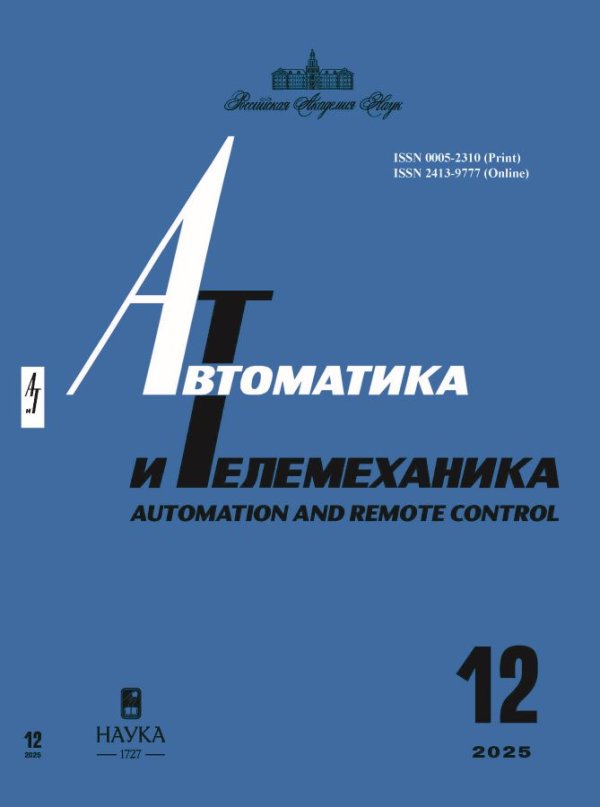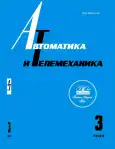No 3 (2023)
Nonlinear systems
Neural Network Algorithm for Intercepting Targets Moving along Known Trajectories by a Dubins’ Car
Abstract
The task of intercepting a target moving along a rectilinear or circular trajectory by a Dubins’ car is formulated as a problem of time-optimal control with an arbitrary direction of the car’s velocity at the time of interception. To solve this problem and to synthesize interception trajectories, neural network methods of unsupervised learning based on the Deep Deterministic Policy Gradient algorithm are used. The analysis of the obtained control laws and interception trajectories is carried out in comparison with the analytical solutions of the interception problem. Mathematical modeling of the target motion parameters, which the neural network had not previously seen during training, is carried out. Model experiments are conducted to test the stability of the neural solution. The effectiveness of using neural network methods for the synthesis of interception trajectories for given classes of target movements is shown.
 3-21
3-21


Spacecraft Transfer Optimization with Releasing the Additional Fuel Tank and the Booster to the Earth Atmosphere
Abstract
This paper considers the idea of reducing the debris of near-Earth space by releasing the spent parts of a spacecraft on orbits touching the conditional boundary of the Earth’s atmosphere. We optimize the spacecraft transfer trajectory from a circular reference orbit of an artificial Earth satellite to a target elliptical orbit in a modified pulse problem statement. The convergence of Newton’s method is improved by introducing a series of auxiliary coordinate systems at each point of applying an impulse action. The derivatives in the transversality conditions are calculated using a special numerical-analytical differentiation technique.
 22-43
22-43


Control Design for a Perturbed System with an Ambiguous Nonlinearity
Abstract
The object of this study is an n-dimensional system of ordinary differential equations with an ambiguous relay nonlinearity under a continuous periodic perturbation. We consider continuous periodic solutions of the system with the state-space trajectory consisting of two parts connected at relay switching points. We develop an algorithm for selecting the nonlinearity parameters under which there is a unique asymptotically orbitally stable periodic solution of the system with given oscillation properties, including a given period and two switching points per period.
 44-64
44-64


Robust, Adaptive and Network Control
Exponentially Stable Adaptive Control. Part II. Switched Systems
Abstract
An adaptive state-feedback control system for a class of linear systems with piecewise-constant unknown parameters is proposed. The solution ensures a global exponential stability of a closed-loop system under condition that a regressor is finitely exciting after each parameters switch, and does not require neither any knowledge of a plant input matrix, nor the switching time instants. The obtained theoretical results are corroborated by numerical simulations.
 65-105
65-105


Control in technical systems
Inverse Kinematics of a 5-DOF Hybrid Manipulator
Abstract
Control of any robotic system cannot be executed without a preliminary solution of the inverse kinematic problem. This problem implies determining the control actions of the actuators required to perform a given motion trajectory and embedded into the control system. The current study considers the inverse kinematics of a hybrid (parallel-serial) manipulator with five degrees-of-freedom (5-DOF). The article first briefly describes the manipulator structure, which includes 3-DOF parallel and 2-DOF serial parts, and then explains an algorithm for solving the inverse kinematics. The algorithm relies on the product-of-exponentials (PoE) formula applied to an equivalent manipulator with a serial structure. The proposed algorithm results in a closed-form solution with no assumptions about the manipulator geometry. A case study confirms the algorithm correctness. The method for solving the inverse kinematic problem can be adapted for other hybrid manipulators.
 106-125
106-125


Thrust Control for Aircraft Landing on a Carrier
Abstract
This paper considers aircraft landing on a carrier. We propose two schemes for calculating, first, the probability of a go-around due to disengaging the arresting gear and, second, the maximum descent of the aircraft’s trajectory with respect to the deck level immediately after leaving the deck. The instant to increase the aircraft’s thrust before touching the deck is a control parameter affecting these characteristics. The requirements imposed on the probability of a go-around and the maximum descent of the aircraft’s trajectory allow determining an admissible range for the thrust increase instant. Numerical results are presented for a real aircraft landing on a real carrier.
 126-138
126-138


Optimization, system analysis, and operations research
Greedy and Adaptive Algorithms for Multi-Depot Vehicle Routing with Object Alternation
Abstract
This paper considers the multi-depot vehicle routing problem with object alternation. We propose a formal statement of the problem with two types of objects and a mathematical model with two blocks of Boolean variables. First, the model is studied without gathering vehicles (mobile objects). Then, a special object (a single collection point) is introduced in the model. We show additional constraints of the mathematical model with this object. Special attention is paid to the condition of no subcycles. This condition is considered based on the adjacency matrix. Five greedy algorithms are proposed for solving the problem, two of which are iterative. One of the greedy algorithms is given a probabilistic modification based on the randomization of variables (an adaptive algorithm). Finally, the proposed algorithms are compared in terms of the average value of the objective function and the running time in a computational experiment. Also, the results of another experiment—the parametric tuning of the adaptive algorithm—are presented.
 139-168
139-168












